To describe the landscapes of an acclaimed American artist known for his images of cakes and candy in terms of the language of food might seem clichéd. But on viewing the paintings of Wayne Thiebaud (b. 1920) in “Land Survey” at Allan Stone Projects in Chelsea, the word delicious cannot help but come to mind.
In Thiebaud’s food paintings, glossy impastos convey simultaneously the swirls of confectioners’ frosting and the sensuous possibilities of paint. At Allan Stone Projects, the best of the artist’s landscapes contain similarly expressive whorls and streaks of color, which now capture the beauty and drama of the surrounding world. These virtuosic brushstrokes can be considered both as representational markings and as pure strokes of pigment. In either case, they entice. They also unsettle.
.
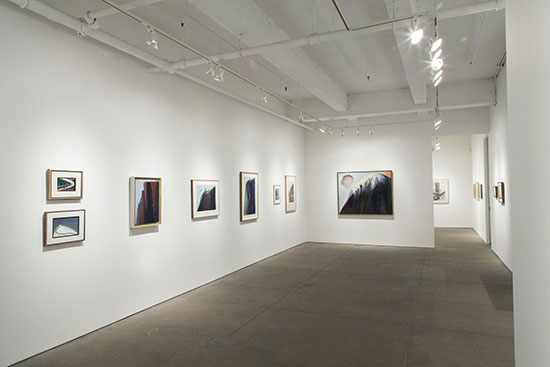
“Wayne Thiebaud: Land Survey” at Allan Stone Projects. Courtesy of Allan Stone Projects.
.
White Mountain is one of the exhibition’s highlights. Painted in 1995, at 48 by 60 inches it is also the largest work in the show, which consists of a number of oil on canvas paintings such as this, as well as smaller studies in various different mediums. Much of the imagery is drawn from Thiebaud’s home location in California and from his birthplace of Arizona, but the works are less literal depictions of landscape than painterly explorations of the experience of place.
.
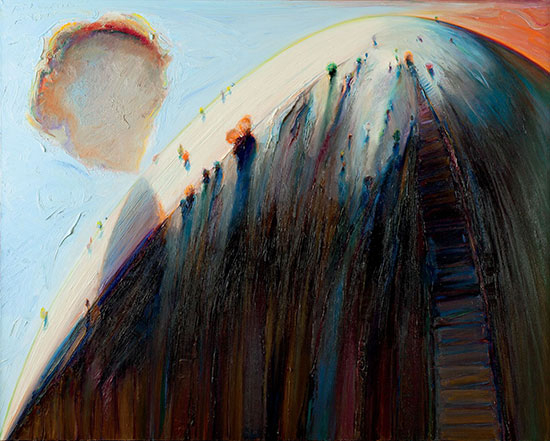
"White Mountain" by Wayne Thiebaud, 1995. Oil on canvas, 48 x 60 inches. Courtesy of Allan Stone Projects.
.
In the case of White Mountain, the lofty splendor of California’s White Mountain peak is encapsulated by a similarly dizzying display of the capabilities of paint. Thick, luscious daubs of pigment form the rounded curve of the cliff top and the surrounding sky. The mountain’s vertiginous effect is recreated through the transition from dark tones, streaked with color, to the paler hues of the sky and the bright white of the snow-covered peak. These contrasts lend the work a vibrancy that is furthered by halation in the blurring of the surrounding color and light. The effect is used compellingly around the mountain and the one signature Thiebaud cloud.
A number of the works have a similar compositional layout to White Mountain: a large landmass positioned to one side, its predominantly dark forms set against a pale background. In Cloud and Bluffs (1972, oil on linen) the thick brushwork used to construct this mass fairly glistens. Sticking with the food analogy, the bluffs are depicted so luxuriously that they resemble layers of chocolate frosting covering a cake.
.
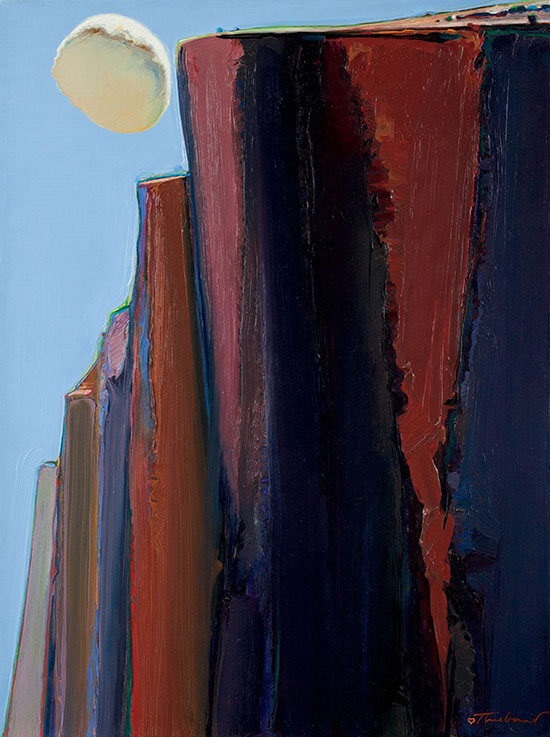
"Clouds and Bluffs" by Wayne Theibaud, 1972. Oil on linen, 24 x 18 inches. Courtesy of Allan Stone Projects.
.
These dark tones give way to a bright green in the mixed media on paper work, Napa Ridge Study (1988). The fields indicated at the top of the bluffs in the previous work here become a vibrant plane of color enlivened by the verticality of vegetation. But the viewpoint of each of these images is curious, for instead of looking up at a landmass from below, or out at the surrounding landscape from its summit, the view is from the side, as though the beholder is a bird in flight, or positioned on the side of a neighboring peak. This sense of distance from the world of humans is apparent in the majority of these landscapes, where people are notably absent.
.

"Napa Ridge Study" by Wayne Theibaud, 1988. Mixed media on paper, 17 x 23 inches. Courtesy of Allan Stone Projects.
.
Still, a particular type of composition included in the exhibition does more clearly indicate a human presence in nature. In 1974 Thiebaud executed a small gouache on paper entitled Valley Farm. He would give the same name to a larger watercolor over aquatint and soft ground etching, which he would complete nearly two decades later, in 1991. Both these studies depict the rounded sweep of a hillside on which a house and a tree are perched precariously. At the foot of the hill a solitary cow is silhouetted against a brightly illuminated, perfectly circular pond.
.
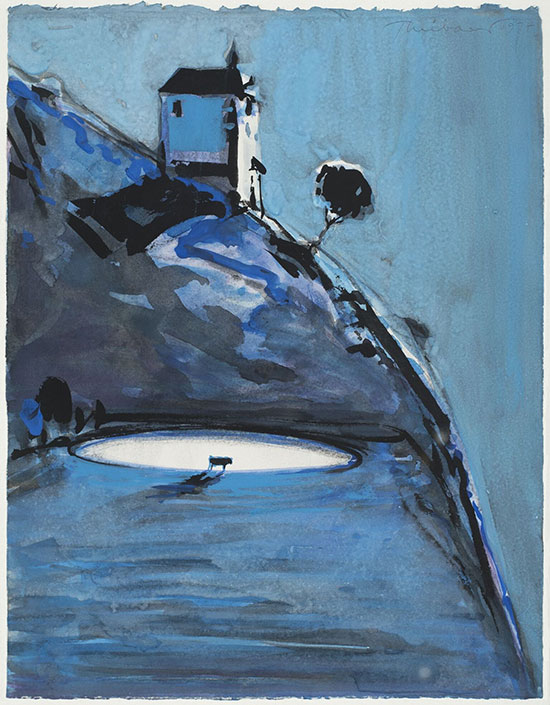
"Valley Farm" by Wayne Theibaud, 1974. Gouache on paper, 11 x 8 1/2 inches. Courtesy of Allan Stone Projects.
.
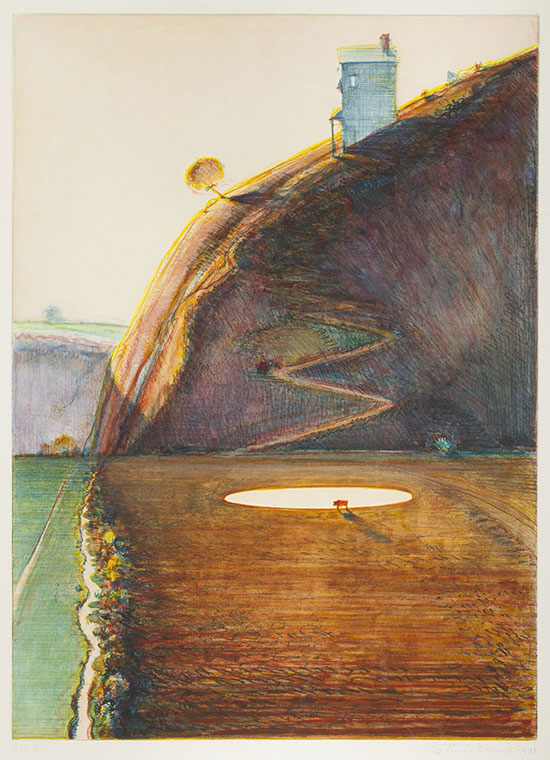
"Valley Farm" by Wayne Theibaud, 1991. Watercolor over aquatint and soft-ground etching, 22 x 16 inches. Courtesy of Allan Stone Projects.
.
As these two works demonstrate, Thiebaud has frequently revisited certain motifs over the course of his long career and has mastered their painterly enticement. Whether the subject is a cake or a cloud, the artist’s consummate rendering seduces the viewer both as a representational image and as an exploration of color and form. But what gives Thiebaud’s images a particular piquancy is the way they often combine the playful and the pleasurable—that solitary cow in a bucolic landscape—with the poignant—the sense of isolation that the single cow and the lonely house on the hill evoke. This melancholic effect is enhanced by the way the landscapes beckon the would-be traveler like a siren’s song while their compositional viewpoints bar access. The beholder is always elsewhere.
Two other paintings, both oil on canvas, encapsulate Thiebaud’s consummate technical skill and his uncanny ability to provide visual pleasure while provoking existential angst. Contrasting with the show’s natural landscapes, Up Street (1993) and Freeway Curve (1995) are roadscapes whose audacious compositional arrangements convey the energetic rush of urban American life. In the former, smudges of different colors on a vertically oriented, pale blue band recalls traffic descending a steep San Francisco street. Yet the pictorial layout is so striking that it resembles a waterfall of cars.
.

"Up Street" by Wayne Theibaud, 1993. Oil on canvas, 24 x 18 inches. Courtesy of Allan Stone Projects.
.
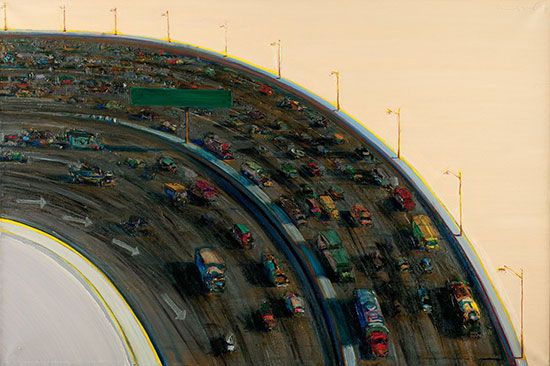
"Freeway Curve" by Wayne Theibaud, 1995. Oil on canvas, 24 x 36 inches. Courtesy of Allan Stone Projects.
.
Freeway Curve is equally dynamic. In this horizontally formatted composition, the pale blue linear street has become a black sweep of California roadway. On close looking the vehicles read as thick daubs of paint, but from a distance their blurred edges and their sheer quantity capture the zoom and thrill of the open road.
To a large extent the vigor of these paintings is due to their melding of representation and abstraction. While they clearly depict roadways, their placement between monotone planes of paint and their framing by bold lines of color remove them from their environmental context. This has the effect of crystallizing the energy of the scenes, but it is also unsettling. There are more indications of humanity in these images than in the natural landscapes but, again, the scenes are bereft of people. All the viewer sees are their cars and trucks, and to either side of the depicted world are voids.
Perhaps the car in the foreground of Up Street is a key to decoding the viewing experience of this exhilarating exhibition. Depicted going over the edge of a multi-striped motorway precipice, it looks like the ride could be fun. But it also, inevitably, leads the viewer to ponder what happens on the other side.
_________________________
BASIC FACTS: “Wayne Thiebaud: Land Survey” is on view October 26 to December 23, 2017 at Allan Stone Projects, 3rd Floor, 535 West 22nd Street, New York, NY 10011. www.allanstoneprojects.com
__________________________
Copyright 2017 Hamptons Art Hub LLC. All rights reserved.
